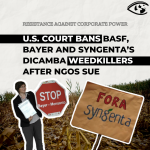US: Senomyx's Fake Flavors
battle for health-conscious consumers: a chemical that tricks the taste
buds into sensing sugar or salt even when it is not there.
Kraft Foods, Nestlé, Coca-Cola and Campbell Soup are all working with a biotechnology company called Senomyx, which has developed several chemicals, most of which do not have any flavor of their own but instead work by activating or blocking receptors in the mouth that are responsible for taste. They can enhance or replicate the taste of sugar, salt and monosodium glutamate, or MSG, in foods.
By adding one of Senomyx's flavorings to their products,
manufacturers can, for instance, reduce the sugar in a cookie or salt
in a can of soup by one-third to one-half while retaining the same
sweetness or saltiness.
Now, for instance, a 10 3/4-ounce can of Campbell's Home-style
chicken soup, which the company says contains two and a half servings,
has more than 2,300 milligrams of sodium. That would probably be cut to
a little over 1,500 milligrams when the chemical is added. (The
government recommends consumption of no more than 2,400 milligrams of
sodium a day.)
Unlike artificial sweeteners, Senomyx's chemical compounds will not
be listed separately on ingredient labels. Instead, they will be lumped
into a broad category - "artificial flavors" - already found on most
packaged food labels.
"We're helping companies clean up their labels," said Senomyx's chief executive, Kent Snyder.
Senomyx, based in San Diego, uses many of the same research
techniques that biotechnology companies apply in devising new drugs.
Executives say that a taste receptor or family of receptors on the
tongue or in the mouth are responsible for recognizing a taste. Using
the human genome sequence, the company says, it has identified hundreds
of those taste receptors. Its chemical compounds activate the receptors
in a way that accentuates the taste of sugar or salt. It is still
experimenting to determine the most potent compounds, its chief
scientist, Mark Zoller, said.
While food safety experts applaud efforts to reduce salt, MSG and
sugar, they expressed concerns about the new chemicals, saying that
more testing needed to be done before these were sold in food.
But Senomyx maintains that its new products are safe because they will be used in tiny quantities.
Kraft, Nestlé, Coca-Cola and Campbell Soup have contracted with
Senomyx for exclusive rights to use the ingredients in certain types of
food and beverages, although the companies declined to identify those
categories.
Elise Wang, an analyst at Smith Barney, said that Kraft was planning
to use Senomyx's sweet flavoring to reduce the sugar in powdered
beverages like Kool-Aid by one-third. Campbell Soup, she said, is
looking at cutting sodium levels by a third with the salt flavoring.
"There's applicability for our soups, sauces and drinks like V8," a spokesman for Campbell, John Faulkner, said.
A Kraft spokesman declined to offer specifics on the company's
relationship with Senomyx, but said that Kraft was committed to
reducing the sugar and salt levels in many products. Nestlé and Coke
also declined to comment.
Senomyx's salt enhancer, in particular, has the potential to be a
boon to the food industry. For years, corporate scientists have been
looking in vain for ways to reduce sodium levels in packaged food
without losing flavor.
"It's a real challenge," said Christine M. Homsey, senior research
food scientist at Food Perspectives, a consulting firm in Plymouth,
Minn. "Nobody's come up with anything even close to ideal."
The Center for Science in the Public Interest, an advocacy group
based in Washington, is seeking to get the Food and Drug Administration
to pay more attention to the high sodium levels in packaged foods. In
February, it filed a lawsuit seeking to force the F.D.A. to regulate
salt as a food additive. The effort, if successful, could spur
companies to limit salt in their products.
Mr. Synder said that Senomyx's salt enhancers were still in the
development phase and would not appear in foods for at least two years.
The company's most advanced product, he said, is its replacement for
MSG, which last month received safety approval from the Flavor and
Extract Manufacturers Association. He expects food items with this
product to appear in supermarkets sometime in the first half of next
year.
While doctors and consumers have recognized the dangers of too much
salt and sugar, MSG is not as well understood as a potentially harmful
food additive. Used as a flavor enhancer, it is found in flavored
chips, sauces, dry soups and meat products.
According to Sara Risch, a food scientist and professor at Michigan
State University, food companies are eager to find replacements for MSG
because some people are allergic to high levels of it.
"There's a negative consumer perception held by some people
regarding MSG," said Mr. Snyder, who came out of retirement in 2003 to
become Senomyx's chief executive. "Some school districts, for instance,
won't sell MSG-containing snacks."
In the 1970's, after it was shown to induce brain lesions and
nervous system disorders in laboratory animals, baby food manufacturers
removed it from their products.
Mr. Zoller, the company's chief scientist, said the replacement for
MSG could also be used in place of common flavor enhancers like
hydrolyzed vegetable protein and autolyzed yeast extract. These
ingredients have been closely linked to MSG because they contain high
levels of glutamic acid, the main component of MSG.
Since Senomyx's flavor compounds will be used in small proportions
(less than one part per million), the company is able to bypass the
lengthy F.D.A. approval process required to get food additives on the
market. Getting the Flavor and Extract Manufacturers Association status
of generally recognized as safe, or GRAS, took Senomyx less than 18
months, including a 3-month safety study using rats. In contrast, the
maker of the artificial sweetener sucralose spent 11 years winning
F.D.A. approval and is required to list the ingredient on food labels.
Michael Jacobson, executive director of the Center for Science in
the Public Interest, endorsed Senomyx's ability to reduce salt, sugar
and MSG, but cautioned against a new chemical entering the food supply
without rigorous testing. "A three-month study is completely
inadequate," he said. "What you want is at least a two-year study on
several species of animals."
Senomyx responded that in contrast to artificial sweeteners, which
are used at levels of 200 to 500 parts per million, its flavorings
would be added in such small quantities that they would pose no safety
risk. These low-use levels are also what allow Senomyx's chemicals to
be classified as artificial flavors.
According to filings with the Securities and Exchange Commission,
Kraft Foods, Nestlé, Coca-Cola and Campbell Soup have collectively paid
Senomyx $30 million to finance research and development. When the
flavorings are incorporated into foods, Senomyx has said it will
collect royalties of 1 percent to 4 percent of a product's sales.
Although the company is several years away from turning a profit,
its stock price has nearly doubled since it went public last June,
closing yesterday at $11.91. Last fiscal year, Senomyx lost $19.7
million on research revenue of $8.3 million. Ms. Wang of Smith Barney
has projected that royalties from food product sales will be $50
million in 2008.
- 181 Food and Agriculture
- 195 Chemicals



